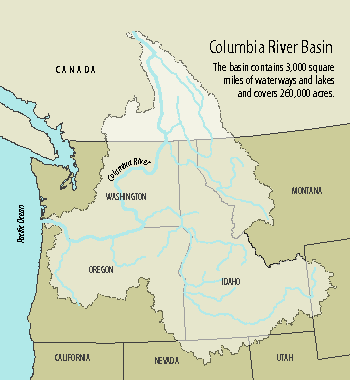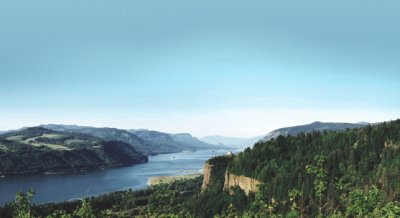Washington state’s success on its Columbia River plan spurs several Oregon efforts to seek expanded water rights and reservoir funding.
Water works
Washington state’s success on its Columbia River plan spurs several Oregon efforts to seek expanded water rights and reservoir funding.
By Robin Doussard
No water, no life.
So intones the glossy DVD that introduces the Oregon Oasis Project. It doesn’t rely on subtleties to get across its point: It pulls out agricultural biggie Bob Hale, Echo farmer Kent Madison and OSU plant researcher Phil Hamm to speak directly to the camera, run soil through their fingers, and state resolutely that Eastern Oregon needs more water from the Columbia River to give the region any chance at growing its economy.
It’s not a new pitch, in Oregon or across the West. The desire to use the Columbia River Basin’s water is long, historic and controversial. The basin, which encompasses 260,000 miles, is a crucial salmon habitat and a crucial people habitat with thirsty cities and fields. The debate over how to best serve fish and human has raged for decades, as salmon runs have faltered and the region’s population continues to grow.
Washington state last year leaped forward on the issue after getting water users and conservationists to agree on a plan that will store more water taken during high-flow winter months; two-thirds of the water will go to irrigators and municipalities, and one-third will go back to the river for fish during July and August. The plan also calls for conservation projects that would offset increased water usage elsewhere. The key to the success of Washington’s Columbia River Management Plan, which went into effect in July, was that state’s governor putting $200 million toward new storage and conservation projects. “We’ve broken the gridlock from the past 20 years, and now we have some hope for the future,” says Keith Phillips, Gov. Chris Gregoire’s environmental policy adviser.
THAT INTENSE AND RIGOROUS FIVE-YEAR EFFORT, lauded in the Seattle press as good for both the environment and economic development, has spurred several in Oregon — the Oregon Oasis Project, the state Water Resources Department, and Republican Sen. David Nelson from Pendleton, whose district covers Morrow, Umatilla, Union and Wallowa counties — to take another run at the Columbia River’s water.
The Oasis Project started as a loose coalition of Eastern Oregon irrigators, businesspeople and community leaders that incorporated as a nonprofit in November, according to Cindy Finlayson, the director of economic development for the Umatilla Electric Cooperative who also works on the Oasis Project. She says the cooperative provided $100,000 to fund the project and probably will give another $100,000. Those involved include electric cooperative CEO Steve Eldridge, Hermiston engineer Fred Ziari, American Onion’s Bob Hale and farmer Chet Prior.
The Oasis Project is drafting a bill for this legislative session that would allow an additional 500,000 acre-feet of water per year to be pulled from the Columbia River year-round. Of that, 300,000 acre-feet would go toward irrigating 100,000 new acres that “would provide jobs, economic development and new taxes for local government.” A two-page summary of the project states these new irrigated acres would be used for “high-market value vegetables and fruits, and the processing of these crops would create over 10,000 new jobs and $452 million per year in added revenue.”
“The governor and the state could do one simple thing to create tremendous economic growth in Eastern Oregon,” says Bob Hale. “Let us use more water.”
Another 195,000 acre-feet would be used to replace “critical groundwater” now irrigating 65,000 acres. And 5,000 acre-feet would go to local municipalities so they would be less dependent upon well water. The plan also calls for a $10 per acre-foot charge on new water permits to fund conservation projects. As of early January, legislative sponsors had not yet been identified, according to Finlayson.
“If you pull water out year-round, you don’t have to fund the big infrastructure costs,” says John Dilorenzo, a lawyer representing the Oasis Project. “There is no science to suggest that the amount we would take during low-flow months would have an impact on fish. Our bill provides immediate relief and doesn’t have a $200 million price tag.” Others would disagree with Dilorenzo; the debate over what fish need has been ongoing for years since the federal opinion on the biological state of the Columbia River system was issued.
Finlayson says the Oasis Project is not a long-term solution; it would sunset in 25 years. “We believe the timing is good” for this to be considered, she says. “This idea has been kicking around for a while. We need to catch up to Washington.”
Finlayson says she has not seen Nelson’s bills, and Nelson says he has not coordinated with the Oasis Project, although both are generally aware of each other’s efforts. Nelson plans to introduce three water-related bills this session, one in concert with a request by the state Water Resources Department (WRD).
NELSON THINKS THE OASIS PROJECT has a big political hurdle in front of it in seeking to draw additional water during low-flow months. He agrees that the Oasis Project is a short-term fix, saying his bills present a long-term solution.
Nelson’s first bill seeks funding for a comprehensive study of the state’s water supply, to be conducted by the WRD, which also has separately requested the $890,000 needed for the study. Debbie Colbert, WRD senior policy coordinator, says her department’s request has been included in the governor’s recommended budget.
“Of the 18 Western states, Oregon is one of only two that are not doing long-term water supply planning,” she says. “This proposal is our first step. We’ve been trying to get our initiative funded for several years now. It’s a milestone that it is in the governor’s recommended budget. Sen. Nelson’s bill supports our plan. The twin effort gives us more opportunities to talk about Oregon’s water needs.” The study would assess existing and future water needs, inventory potential storage sites, assess conservation opportunities, and determine the amount of runoff from the basin each year.
Nelson says his other two bills seek to mirror Washington’s plan, asking for $200 million to fund storage projects. It would start with a pilot project that would store about 50,000 acre-feet of water, to be pulled only during the high-flow winter months, in a reservoir in Juniper Canyon. The bills also seek to allow additonal water to be drawn from the Columbia in more months.
In Washington, Phillips says, “We hired the best science, and got an independent economic review, and used them as the cornerstones. The science surprised us.” That research helped lead to the agreement that more water could be taken out during periods previously restricted.
Since 1994, after salmon were listed as endangered, water users in Oregon have been required to provide mitigation (essentially, replace the water taken) in order to get new water rights from the Columbia above the Bonneville Dam from April 15 to Sept. 30. There is no moratorium on new Columbia rights, says Colbert, ”but there are public interest standards that apply during that critical fish period.” But the net effect of this has meant very few new water rights have been issued since then.
Colbert says the state has never barred winter water from being pulled, adding, “we just don’t have the infrastructure to store it.” For example, she notes that Pendleton currently is taking high winter flows from the Umatilla River and putting it into its municipal wells.
Despite the debates that are certain to surround these newly launched water efforts, there is one truth held by all sides: No water, no life. For fish or human.
Have an opinion? E-mail [email protected]


